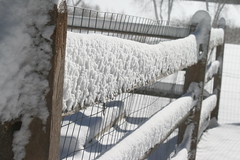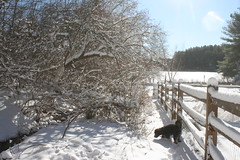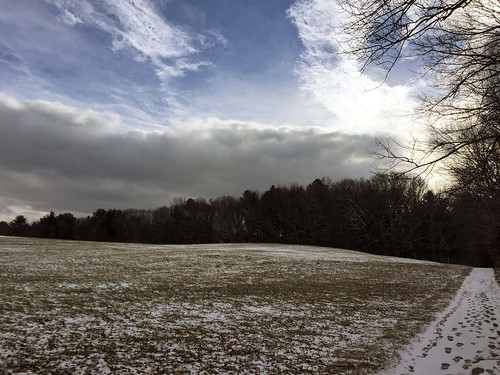I recently finished making plans for my vegetable gardens and posted the diagrams. A reader noticed I always plant my butternut squash in one place: on the arbor in the middle of my community garden plot. I like it there. It looks nice and does well.
But the reader asked: Why don't you rotate its location?
Well my view is crop rotation is more often important for farmers growing big fields of vegetables. Growing in a small space is different. It's hard to separate plants in a 500 sq ft space. I've heard and read this, most recently from Victory Garden TV host Roger Swain at a class he gave for my Master Gardener training.
Crop rotation can be done to reduce pathogens or build soil. When thinking about pathogens, many are windbourne or spread by insects, splashing, tools, or the gardener. For these, moving crops a few feet to another bed doesn't help much. There are also crops that don't have many pests in a given area and there's no need to rotate these.
Crop rotation to build soil is a great idea even in a small garden. Squash is a heavy feeder, so I could plant a crop that doesn't like a rich soil, like carrots, in it's place the second year, and then a legume like pole beans to build up the soil the third year, and then in the fourth year go back to squash. Maybe some year I'll try this. Drawbacks are the time it takes to plan out the cycles. Also, here is a tendency for home gardeners to grow many more heavy feeding plants than light feeders or soil builders. And, it's not so hard to get a few shovelfuls of compost and enrich a small patch of soil annually. Anyway I don't rotate for soil building.
I do make sure to rotate crops that are susceptible to soil pathogens in my gardens. These include: 1. Root vegetables, 2. Tomatoes, and 3. Brassicas.
My root vegetables include carrots, parsnips, potatoes, sweet potatoes, onions, garlic, and scallions. (I haven't seen any problems without rotating celeriac and beets.) All alliums (onions, garlic, leek, scallions) need to be considered the same and none should go in the same bed without a break. I rotate them on a three year schedule. The same for tomatoes and brassicas. (My brassicas include broccoli, bok choi, cabbage, and kale.) To make it easier to rotate these, I plant each in their own bed.
Plants I don't rotate are my greens, legumes, herbs, flowers, and squashes. These don't benefit enough from rotating in my small garden. For example, my squash is prone to stem borer, downy mildew, and cucumber beetles. Moving its location won't reduce these. So I add a good pile of compost along my arbor and keep planting the butternuts there.
I'd love to hear how other gardeners handle crop rotation. I'm sure there are lot's of approaches.
This is a journal of my vegetable gardens. Skippy was my first dog and he thought the garden was his, even though I did all the work. Now Suzie and Charley follow in his footsteps. We're located near Boston (USDA zone 6A). I have a community plot, a backyard vegetable garden, fruit trees, berry bushes, chickens, and bees. I use sustainable organic methods and do my best to grow all of my family's vegetables myself.
Monday, January 30, 2017
Saturday, January 28, 2017
garden plans
Thursday, January 26, 2017
I'm working on my garden plans today and hope to be done tomorrow. I'm encorporating crop rotation and allocating space for all of the varieties I want to grow. Plus, I want to include lots of flowers that attract beneficial insects and make the gardens beautiful. I want to reduce planting in rows this year and go for more patches and combined plantings.
Wednesday, January 25, 2017
Charley and the chickens

That's my chicken coop behind my inquisitive and always "up-for-the-chase" five month old puppy. Charley caught one of my chickens the other day. The pretty black one I call Penny. Prey instinct kicked in. He chased and caught her, held her for several seconds in his jaw before my husband got there and pulled him off. Penny was scared but fortunately no damage done. Now we don't let Charley out when the chickens are out. It's one or the other. I don't know if this is just a puppy thing. We'll see.
Tuesday, January 24, 2017
a gray day
Sunday, January 22, 2017
planting shelves, seeds, and trays
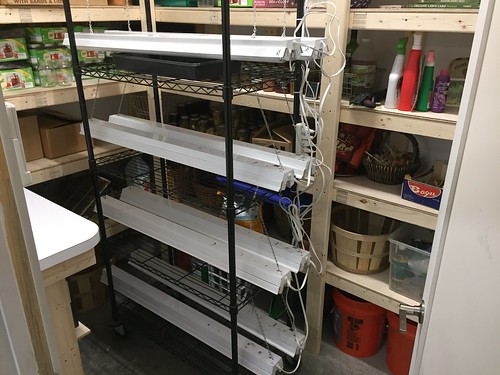
My planting shelves and lights are ready to go! My husband set them up for me. (Thanks Steve!) Rather than putting them in the garage this year, they are in a small pantry where I store my canned goods, books, etc. I can adjust the temperature in here without heating up a large room. Last year they grew very slowly in the 60F garage.
I addition to having the shelves ready, I just sent out my last seed order - the snail mail one to Sand Hill. I'm enjoying seeing my new seeds arrive in the mail. I'll have to show a photo soon of my seed collection as I have a new way of organizing and storing them
Next - I have to get my trays and seed pots cleaned up. 4 WEEKS 'TIL PLANTING - and counting!!
Saturday, January 14, 2017
seed catalog
Today I ran across a seed company I didn't know about. NE Seed Co. They have a really nice catalog. I was getting my haircut and they had the catalog on the table. What hair salon has seed catalogs! Great reading. I just requested a copy. I can always find room for a few more varieties in my garden, but mostly I want to finish reading it.
NE Seed Co is a seed distributor located in Hartford CT.
Friday, January 13, 2017
5 weeks 'til I start planting!
It's 16 weeks 'til my last spring frost - which means only 5 weeks 'til I start planting! OK, it's still a while, but why not start getting ready. I have to clean off my plant shelves, get my pots and trays out of the garden shed and clean them all, make sure I have potting soil, and get my seeds ready to go.
I'll be using my planting app again. It's made it very easy for me to keep up with what to plant when. It's at the Apple Store and Google Play. We're in the process of making some upgrades, which should be fun.
The app has no flashy graphics like other planting apps, but also unlike others - it's written by gardeners, contains a lot of information and flexibility, it's very simple to use, no in-app purchases, and it incorporates feedback from the many gardeners who read this blog. Now that I've finished my gardening class, I can also say that the app was written by a "Master Gardener"! Anyway, I find it very useful.


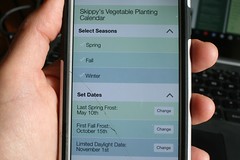

If you search the Apple store for "vegetable" it's the second app listed, and our other apps follow. Or you can use this link: http://skippysgarden.com/apps/ We have two apps, a "Vegetable" app and an "Herb and Flower" app. The Vegetable app, has three versions: Spring only, Fall only, Winter only (each $0.99), and the full season app ($1.99).
I'll be using my planting app again. It's made it very easy for me to keep up with what to plant when. It's at the Apple Store and Google Play. We're in the process of making some upgrades, which should be fun.
The app has no flashy graphics like other planting apps, but also unlike others - it's written by gardeners, contains a lot of information and flexibility, it's very simple to use, no in-app purchases, and it incorporates feedback from the many gardeners who read this blog. Now that I've finished my gardening class, I can also say that the app was written by a "Master Gardener"! Anyway, I find it very useful.




If you search the Apple store for "vegetable" it's the second app listed, and our other apps follow. Or you can use this link: http://skippysgarden.com/apps/ We have two apps, a "Vegetable" app and an "Herb and Flower" app. The Vegetable app, has three versions: Spring only, Fall only, Winter only (each $0.99), and the full season app ($1.99).
Charley outgrew his puppy collar today and I got out one of Skippy's. It looks good on him. Suzie sniffed and I think she likes it too. Charley's growing up fast. His last Puppy K class is tomorrow. I haven't told him yet, but he's going to have to take the next two levels of Puppy training too. He's as tall as Suzie now, but slim - 30 lbs to her 40. And very very handsome.
Thursday, January 12, 2017
"aerial" garden photo
I was able to get an aerial view of my "new" garden. (Actually not so new any more - this is it's 4th year.)

My husband gave me a beautiful new pruning ladder for Christmas. I was able to place it at the top off the slope to the west of the garden and shoot a photo though the branches. I'd like to follow my garden through the year from one location. I wish I could get up a bit higher, but this is the top of the slope. Not as good as my old viewpoint from the second floor right above the garden. Maybe I can find a tree to climb with this new ladder...


My new ladder is tall enough for me to prune our overgrown bushes. My guess is the bushes in the photo on the right are a variety Chamaecyparis pisifera Threadleaf False Cypress. Maybe ‘King’s Gold’. They'll look better if they are thinned out, shorter, and fuller.
These photos are quite a contrast to the ones I posted last. We've had two rain storms and weather in the 60's! All of our snow is gone - replaced by mud. I opened up my winter tunnel to give it some fresh air. There are some nice bok choi that I can harvest soon.

My husband gave me a beautiful new pruning ladder for Christmas. I was able to place it at the top off the slope to the west of the garden and shoot a photo though the branches. I'd like to follow my garden through the year from one location. I wish I could get up a bit higher, but this is the top of the slope. Not as good as my old viewpoint from the second floor right above the garden. Maybe I can find a tree to climb with this new ladder...


My new ladder is tall enough for me to prune our overgrown bushes. My guess is the bushes in the photo on the right are a variety Chamaecyparis pisifera Threadleaf False Cypress. Maybe ‘King’s Gold’. They'll look better if they are thinned out, shorter, and fuller.
These photos are quite a contrast to the ones I posted last. We've had two rain storms and weather in the 60's! All of our snow is gone - replaced by mud. I opened up my winter tunnel to give it some fresh air. There are some nice bok choi that I can harvest soon.
Monday, January 09, 2017
Saturday, January 07, 2017
approaching snow storm
Friday, January 06, 2017
I lost both my bee hives already

:-( The boxes of both my hives are now empty and stacked crosswise. I was sad to see so many bees die. I am guessing they died from dripping condensation as I saw water droplets in the hive when I opened it. I noticed bees begin to die in November, just after it got cold. (more ...)
Thursday, January 05, 2017
New Year's "sort-of-resolutions"
I've made a list of things I'd like to do better, or differently, in my garden this year. Not necessarily "resolutions", but things to try to do. And not too many things. Three seems like a good number.
Label plants better: I think this has been on my New Year's to-do list for several years now. One problem is that I like to use compostable wood labels, but they, hmm, compost, in garden soil during the season. I'm going to use plastic this year. I'd really like to know what's in my garden.
Save more seeds: This "resolution" is an incremental one. I don't want to save ALL my seeds, just a few more. Saving seeds is easy for many plants, saves money, and in the long run can produce strains that are better adapted to my garden. It also gives that sense of satisfaction and connectedness to food and garden. Vegetables to save seed from should be OP (open pollinated) varieties - meaning that they breed true if they are not cross pollinated. They should also be varieties that I love to grow every year. I save a number of flower seeds, but not many vegetables. Here's my list to try for: (* means one's I already save)
Basil: Superbo
Beans: Maxibel, Jumbo, Shung Wang*, Wax pole*
Corn: Baby Golden Popcorn
Peppers: Thai Hot*, Joe Parker Numex
Soy Beans: R Swain Green
Tomato: Opalka, Polish Linguisa, Mortgage Lifter
This list has 12 varieties. Three that I already save: two pole beans and a pepper. Ten additional varieties. Beans, peppers, soy beans, and tomatoes are easy to save since cross pollination is rare. Corn bees will be easy for me - even though they cross pollinate I'll only grow one variety of each.
Prepare my soil better: Good soil is the most important thing for a vegetable garden. Mostly this requires soil tests (every 4-5 years is good), addition of appropriate amendments, and usually lot's of compost. But it's easy to skimp on compost if time is short. I'll make it a priority in the spring to test and appropriately amend my soil.
Label plants better: I think this has been on my New Year's to-do list for several years now. One problem is that I like to use compostable wood labels, but they, hmm, compost, in garden soil during the season. I'm going to use plastic this year. I'd really like to know what's in my garden.
Save more seeds: This "resolution" is an incremental one. I don't want to save ALL my seeds, just a few more. Saving seeds is easy for many plants, saves money, and in the long run can produce strains that are better adapted to my garden. It also gives that sense of satisfaction and connectedness to food and garden. Vegetables to save seed from should be OP (open pollinated) varieties - meaning that they breed true if they are not cross pollinated. They should also be varieties that I love to grow every year. I save a number of flower seeds, but not many vegetables. Here's my list to try for: (* means one's I already save)
Basil: Superbo
Beans: Maxibel, Jumbo, Shung Wang*, Wax pole*
Corn: Baby Golden Popcorn
Peppers: Thai Hot*, Joe Parker Numex
Soy Beans: R Swain Green
Tomato: Opalka, Polish Linguisa, Mortgage Lifter
This list has 12 varieties. Three that I already save: two pole beans and a pepper. Ten additional varieties. Beans, peppers, soy beans, and tomatoes are easy to save since cross pollination is rare. Corn bees will be easy for me - even though they cross pollinate I'll only grow one variety of each.
Prepare my soil better: Good soil is the most important thing for a vegetable garden. Mostly this requires soil tests (every 4-5 years is good), addition of appropriate amendments, and usually lot's of compost. But it's easy to skimp on compost if time is short. I'll make it a priority in the spring to test and appropriately amend my soil.
Wednesday, January 04, 2017
my (and my mom's) birdfeeders
My bird feeders are a hodgepodge: half falling over, half broken, and more often empty than filled. Today, the birds and squirrels have emptied most of them.


This green feeder is my nicest, even though it's bent and faded. A spring-loaded perch closes when a large bird or squirrel tries to eat. Only smaller birds can perch and get at the seeds. It's very nice. Problems I've had with it: larger seeds get stuck, accumulate, and clog up the seed opening; it seems that water gets into the seed area somehow. Now that I look, the "spring" (that little wire) is sticking out. I'll need to fix that.
The feeder on the left below is like my mom's. She has empty plastic bottles strung on a cord that holds several feeders. No squirrels. My feeder on the right below is on a pole - until it falls over.... There's a plastic platform below the feeder. Squirrels can't get up the pole past the platform. So - no squirrels. However big birds, like blue jays, can get on it. Often they hog it keeping small birds away.


My feeder on the left below is freely available to almost any bird or squirrel that comes by. Squirrels hang down and eat for what seems like hours. My thistle feeder is on the right below. No squirrels can get up - or maybe they're not interested in thistle.




This green feeder is my nicest, even though it's bent and faded. A spring-loaded perch closes when a large bird or squirrel tries to eat. Only smaller birds can perch and get at the seeds. It's very nice. Problems I've had with it: larger seeds get stuck, accumulate, and clog up the seed opening; it seems that water gets into the seed area somehow. Now that I look, the "spring" (that little wire) is sticking out. I'll need to fix that.
The feeder on the left below is like my mom's. She has empty plastic bottles strung on a cord that holds several feeders. No squirrels. My feeder on the right below is on a pole - until it falls over.... There's a plastic platform below the feeder. Squirrels can't get up the pole past the platform. So - no squirrels. However big birds, like blue jays, can get on it. Often they hog it keeping small birds away.


My feeder on the left below is freely available to almost any bird or squirrel that comes by. Squirrels hang down and eat for what seems like hours. My thistle feeder is on the right below. No squirrels can get up - or maybe they're not interested in thistle.


Tuesday, January 03, 2017
backyard birds
Sunday, January 01, 2017
New Year's lists
New Year's Day is a good time for looking forward and making lists. I haven't made a resolution list. I'm not so big on them since I'm usually not disciplined enough to follow through. I do like to write up seed lists. I love a new year and a new garden to think about.
I've just finished up my 2017 variety list - between New Year's family activities, and a lot of food, drink, and generally celebration. My list has 118 different varieties of vegetables, herbs, and flowers. Of these, I need to buy (or share with other gardeners) 22 seed packets. (Most of my seeds I save year to year.)
I am ordering seeds from five companies. Just one package from Amazon: Superbo, my favorite basil and hard to find. But a number of packets I'll buy from three companies: Johnny's Selected Seeds, Sand Hill Preservation, and Hudson Valley Seeds. I was impressed with the difference in seed and shipping costs. These are the averages for my selections:
Company Ave small seed packet cost Shipping
Johnny's $4.47 $6.75
Hudson $3.32 $3.87
Sand Hill $1.70 $3.00
I ordered most of my seeds from Sand Hill Preservation this year. They do everything in paper and by snail mail. All their seeds are OP (which means no hybrids). So not only are their prices great, but the seeds breed true when saved (if they aren't cross pollinated). Sometimes I really want to grow a newer hybrid (I love Johnny's!), but it's nice to compare varieties - and prices!
My potatoes will come from Fedco again this year. They're a whole different category of pricing, but then shipping 5 lbs of a perishable costs more than shipping seed packets. My potatoes cost $6.75 (5 lbs) and shipping is $14.30. A cost saver for potatoes was recommended by Roger Swain at my gardening class. He buys certified disease free potatoes and then saves the ones he grew for seed 3-4 years. After that time, he disposes of the potatoes and starts over with certified disease free potatoes. He said it takes about that amount of time for potatoes to accumulate pathogens that can affect growth.
My list is a couple posts down. A may yet do a resolution list - though I'll probably call something less definitive. Maybe a "things-to-think-about-doing list".
Happy New Year! I hope it's healthy, happy, and hopeful for everyone.
I've just finished up my 2017 variety list - between New Year's family activities, and a lot of food, drink, and generally celebration. My list has 118 different varieties of vegetables, herbs, and flowers. Of these, I need to buy (or share with other gardeners) 22 seed packets. (Most of my seeds I save year to year.)
I am ordering seeds from five companies. Just one package from Amazon: Superbo, my favorite basil and hard to find. But a number of packets I'll buy from three companies: Johnny's Selected Seeds, Sand Hill Preservation, and Hudson Valley Seeds. I was impressed with the difference in seed and shipping costs. These are the averages for my selections:
Company Ave small seed packet cost Shipping
Johnny's $4.47 $6.75
Hudson $3.32 $3.87
Sand Hill $1.70 $3.00
I ordered most of my seeds from Sand Hill Preservation this year. They do everything in paper and by snail mail. All their seeds are OP (which means no hybrids). So not only are their prices great, but the seeds breed true when saved (if they aren't cross pollinated). Sometimes I really want to grow a newer hybrid (I love Johnny's!), but it's nice to compare varieties - and prices!
My potatoes will come from Fedco again this year. They're a whole different category of pricing, but then shipping 5 lbs of a perishable costs more than shipping seed packets. My potatoes cost $6.75 (5 lbs) and shipping is $14.30. A cost saver for potatoes was recommended by Roger Swain at my gardening class. He buys certified disease free potatoes and then saves the ones he grew for seed 3-4 years. After that time, he disposes of the potatoes and starts over with certified disease free potatoes. He said it takes about that amount of time for potatoes to accumulate pathogens that can affect growth.
My list is a couple posts down. A may yet do a resolution list - though I'll probably call something less definitive. Maybe a "things-to-think-about-doing list".
Happy New Year! I hope it's healthy, happy, and hopeful for everyone.
Subscribe to:
Comments (Atom)





